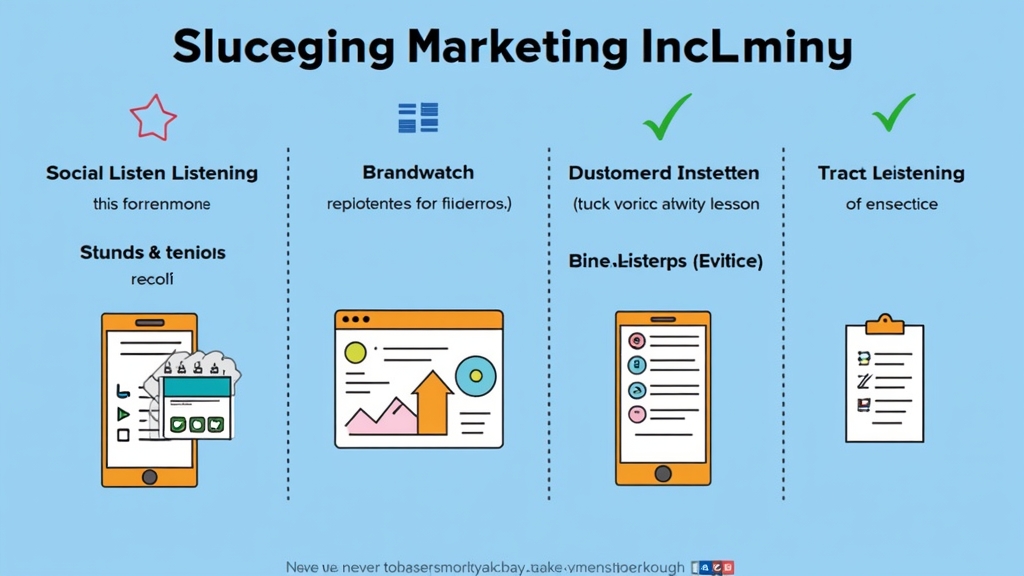Effective Marketing: Social Listening Strategies for Success
Introduction
Understanding Social Listening in Marketing
Social listening is a powerful tool that helps brands understand what people are saying about them online. It involves tracking conversations on social media and other platforms to gather insights into customer opinions, preferences, and trends. By paying attention to these discussions, you can better connect with your audience and improve your marketing strategies.
The Importance of Social Listening for Brands
In today’s digital world, consumers have a loud voice. They share their thoughts and experiences openly, making it essential for brands to listen actively. Social listening allows you to identify potential issues before they escalate and discover opportunities for engagement. This proactive approach not only enhances customer satisfaction but also strengthens brand loyalty.
Key Components of Social Listening Strategies
Monitoring Brand Mentions and Sentiment
One of the first steps in social listening is monitoring brand mentions across various platforms. This means keeping track of when people talk about your brand, products, or services. You should also analyze the sentiment behind these mentions—are they positive, negative, or neutral? Understanding sentiment helps you gauge public perception and respond appropriately.
Analyzing Competitor Activity and Insights
Another crucial aspect is analyzing what competitors are doing. By observing their social media activity, campaigns, and customer interactions, you can gain valuable insights into industry trends. This information can help you identify gaps in the market or areas where you can differentiate your offerings from those of your competitors.
Tools and Technologies for Social Listening
Overview of Popular Social Listening Tools
Several tools can assist with social listening efforts. Some popular options include Hootsuite Insights, Brandwatch, and Sprout Social. These platforms allow you to track mentions across multiple channels while providing analytics on sentiment analysis and audience demographics.
How to Choose the Right Tool for Your Needs
When selecting a social listening tool, consider factors like budget, features offered, ease of use, and integration capabilities with existing systems. A good tool should provide real-time data analysis while being user-friendly enough for your team to utilize effectively.
Implementing a Social Listening Strategy
Steps to Develop a Comprehensive Strategy
To create an effective social listening strategy:
- Define clear objectives.
- Identify key topics relevant to your brand.
- Select appropriate tools.
- Train your team on how to use these tools effectively.
- Regularly review findings to adapt strategies as needed.
By following these steps diligently, you’ll be well-equipped to harness the power of social listening.
Best Practices for Engaging with Your Audience
Engagement is vital in social listening strategies. Respond promptly to comments or questions from customers; this shows that you value their input! Additionally, share content that resonates with your audience based on insights gathered through monitoring discussions online.
Measuring the Impact of Social Listening
Key Metrics to Track and Analyze
To evaluate the effectiveness of your social listening efforts:
- Track engagement rates (likes/comments/shares).
- Monitor changes in brand sentiment over time.
- Assess website traffic generated from social media referrals.
These metrics will help determine whether you’re meeting your objectives.
Case Studies of Successful Implementation
Many brands have successfully implemented social listening strategies leading them toward greater success! For instance:
- A major beverage company used insights from consumer feedback on Twitter which led them redesigning packaging that appealed more directly towards younger audiences.
Such examples highlight how impactful effective strategies can be!
Challenges in Social Listening
Common Pitfalls to Avoid
While implementing a strategy may seem straightforward at first glance there are challenges too! One common pitfall includes ignoring negative feedback instead focusing solely on positive remarks—it’s important not just hear praise but also learn from criticism!
How to Address Privacy Concerns
Privacy concerns are another challenge worth addressing head-on; ensure compliance with regulations such as GDPR when collecting data so users feel safe sharing opinions without fear repercussions!
Future Trends in Social Listening
The Role of AI and Automation
As technology continues evolving artificial intelligence (AI) plays an increasingly significant role within this space—automating tasks like data collection & analysis allowing marketers focus more strategic aspects rather than mundane ones!
Evolving Consumer Expectations
Consumer expectations are also changing rapidly; today’s customers expect personalized interactions based upon past behaviors/preferences which means businesses must adapt quickly if they want remain competitive landscape!
Conclusion
Recap of the Importance of Social Listening in Marketing
In summary: adopting effective marketing through robust approaches enables organizations stay ahead curve by understanding both current trends emerging opportunities alike—all thanks leveraging power behind insightful conversations happening around us daily!
Final Thoughts on Building Effective Strategies
Ultimately remember: successful implementation requires ongoing commitment effort—but rewards gained far outweigh challenges faced along way!
📢 Explore More: Continue Your Journey!
If this article helped you understand how important social listening is for marketing success check out “The Power of Customer Feedback”! It covers how gathering direct input from customers can enhance product development processes effectively.














![NEEWER 55W 18"/45cm Ring Light Kit [New Version], 5600K Dimmable ...](https://m.media-amazon.com/images/I/414QLqvZWLL._AC_.jpg)








